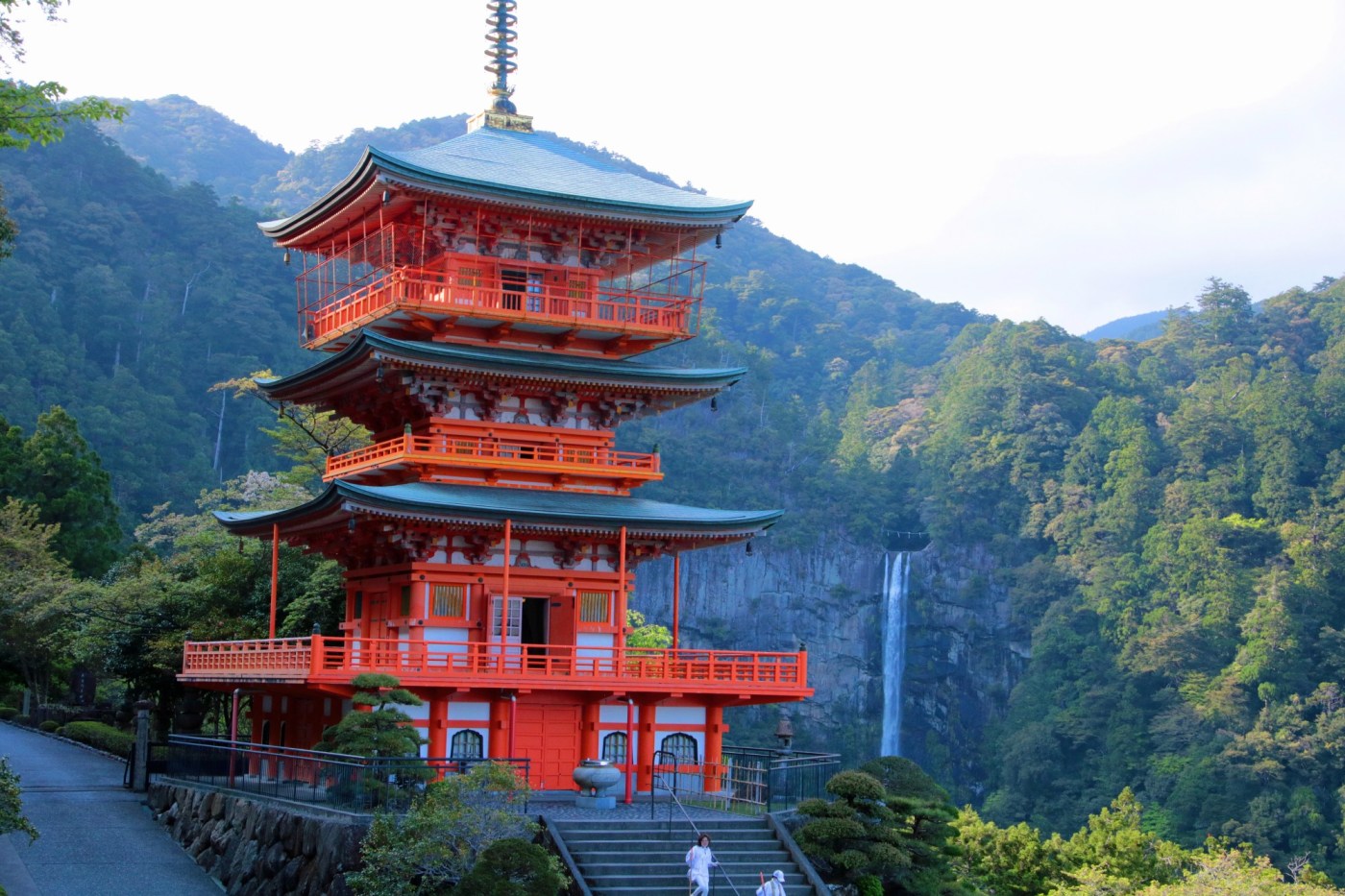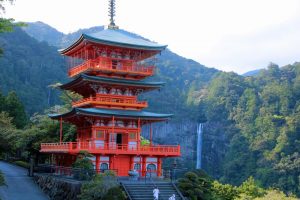
Travel: Take a hike through ancient history in rural, mountainous Japan
Revered for guiding, the three-legged crow god surely had my back. In rural mountainous Japan, I hoofed up the steep Kumano Kodo trail, retracing ancient footsteps of emperors, shoguns, and nobles who trekked this same pilgrimage route seeking spiritual salvation more than 1,000 years ago.
Mystical vibes wafted through the serene, dense, lore-loaded forest of towering cedar, cypress and camphor trees. A sign at the hallowed “milk rock” noted a wolf somehow dripped milk from the stone to save a warlord’s newborn son until the infant’s parents finished their divine journey. Knee-high, eroded Jizo statues that resembled children — often cloaked in red bibs — peppered the trail to ward off evil and safeguard wayfarers like me.
Representations of the three-legged crow god Yatagarasu are omnipresent at the Kumano Kodo’s three Grand Shrines. According to legend, the crow guided Japan’s first emperor when he became lost in the area over 2,500 years ago. (Photo by Norma Meyer)
The Kumano Kodo is one of only two UNESCO World Heritage pilgrimage routes (the other being Spain’s famed Camino de Santiago) and evolved from nature worship; deities lived in the bamboo groves, gurgling brooks, cascading waterfalls, and evergreen trees. I can personally attest to their auras. By the 15th century, so many sandal-clad commoners clogged the long arduous trail in search of holy rejuvenation, it became known as the “pilgrimage of ants.” The ultimate destinations in this Land of Gods have always been three eminent Grand Shrines, where I dutifully purified myself with water from a dragon spout, did sacred bell-ringing rites, asked for the world to become sane, and bought coveted good-health amulet pouches for family and friends.
The post town of Narai is an authentic centuries-old gem on the Nakasendo Way. You can imagine samurai walking through the hamlet. (Photo by Norma Meyer)
Moving on, in a different region of Japan, I time-traveled (in my hiking boots) along another historic path, the centuries-old Nakasendo trail once used for commerce and still flecked with authentic post towns that look like Hollywood movie sets. Feudal barons, samurai, merchants and princesses regularly took this route in the Japanese Alps to get between political hubs Kyoto and Tokyo.
These two off-the-beaten-track walks headlined “Japan Hiking Highlights,” an enthralling 11-day small-group trip run by tour operator Oku Japan (okujapan.com). Our trail treks each averaged over three hours, and with added roving, I tallied between six and 10 miles a day. Stop me from whining about the blister on my baby toe, because our cadre of 11 adventurers included a hardy Vermont couple in their 80s, both retired surgeons, who blew by me on their trekking poles. Besides mythical keen-eyed crow Yatagarasu, an enthusiastic Oku Japan guide briskly led our pack.
Springtime cherry blossoms greet hikers at a teahouse rest stop along Japan’s Nakasendo trail. (Photo by Norma Meyer)
Throughout our April voyage, heavenly cherry blossoms bloomed and snowed pale-pink petals upon us. And we weren’t always sweaty and carrying backpacks while our luggage was forwarded every three days. Our tour launched in Kyoto, where we enjoyed a nine-course Japanese-style lunch with Sayumi, a gracious, white-powder-faced 20-year-old apprentice geisha (maiko) who slowly performed a solemn 400-year-old dance and filled us in on her venerated profession via a translator, between stifling dainty giggles with her hand.
Sayumi, who is a maiko or apprentice geisha in Kyoto, continues Japan’s long-esteemed tradition of performance artists. (Photo by Norma Meyer)
Geishas are upper-class entertainers and genteel Sayumi already is an accomplished musician, singer, calligrapher, and tea ceremony host. (Also, she’s never had a mobile phone and her favorite foods are pizza and McDonald’s.) We concluded our trip in Tokyo among the neon marquees, bustling crowds and infamous Asahi beer headquarters adorned with a massive flame-like sculpture that locals dub the “golden turd.”
Typical tatami-matted rooms, such as this one, provide a good night’s sleep at ryokans during an Oku Japan hiking trip. (Photo by Norma Meyer)
On the road, we stayed at ryokans, traditional inns that immersed us in Japan’s fascinating culture and warm, genuine hospitality. From the moment we dumped our shoes at the foyer, all 11 of us received cotton yukata kimonos and slippers to wear around, including to the ryokan’s fresh-cooked dinners doubling as culinary works of art. Yukata kimonos had to be crossed left over right before tying, because the opposite is how the Japanese dress the dead. I slept on the floor on a futon atop tatami mats (you can only tread on those barefoot or in socks) and put on special slippers designated for the toilet area.
Ryokans are also celebrated for their hot spring onsens, which are large communal mineral baths segregated for men and women. Westerners might find the strict onsen etiquette a bit uncomfortable — first you sit naked among others on a diminutive stool and clean yourself with either buckets of water and soap or a hand-held spray. Next, you can use the scant eight-inch-wide “modesty towel” to cover yourself while you join, in my case, other female au naturel bathers but the towel then must be placed upon your head. Swimsuits are forbidden. Trust me, the meditative soaking did wonders for my quads.
Communing on the Kumano Kodo
After a three-hour train ride from Kyoto followed by a 40-minute bus jaunt and a tasty bento box, we arrived at the Takijiri trailhead of the classic imperial Nakahechi route, one of several pathways of the Kumano Kodo.
Lush ferns and trees cocoon walkers on the Kumano Kodo, one of two global UNESCO World Heritage pilgrimage routes. (Photo by Norma Meyer)
I didn’t worry about the poisonous mamushi snakes, the giant stinging “murder hornets,” or the jumbo venomous mukade centipedes because Kumano’s almighty mountain god was by my side. Although he obviously didn’t believe in switchbacks. Within seconds, I understood why the inaugural 2.8 miles are the most challenging; during that mere distance, we climbed nearly 1,400 feet straight up the Kii Mountains with some descents in between.The terrain was uneven with haphazard rock stairs, moss-coated cobblestone steps, and exposed tree roots twisting through the ground.
“You are sitting where an emperor sat,” my guide Maru said, as I plopped on a random boulder.
We rarely saw other hikers; nightingales gloriously sang, piercing the silence. It took us about three hours to complete the 2.8 miles, before ending for the night. And then, I was Zen.
Jizo statues on the Kumano Kodo are guardians of children and travelers; the bibs are red, a color deflecting danger and illness. (Photo by Norma Meyer)
Over the next two days, we clomped along other segments, Buddhist and Shinto elements always cheering us on. We humbly shuffled under sacred wood torii gates festooned with shide, the zig-zagging folded white papers that represent purity and protection. Smaller oji sub-shrines, guarded by lion-dog statues, dappled the trail. So did the Jizo stone figures, heralded for watching over children and travelers and memorializing pilgrims who died walking the Kumano. One Jizo was cracked down the middle; a sign encouraged travelers to slip coins into the crevice “and pray for relief from their backaches.”
The sacred gate at the Kumano Hongu Shrine is strung with thick straw ropes called shimenawa and intended to ward off evil. (Photo by Norma Meyer)
My legs ferried me past terraced rice paddies, two goats chomping hay at a farmstead, and a woodworker’s shed of chiseled lucky owls. Eventually we reached the sprawling complex of Kumano Hongu Taisha, one of the three esteemed Shinto shrines of the Kumano and dedicated to the sun goddess and other deities. The ritual at all the shrines starts with purifying yourself at an ablution basin by washing your hands with a ladle and rinsing your mouth. Then you can approach the worship hall’s exterior, put coins in an offering tray, ring a thick roped bell to alert the gods, deeply bow twice, clap hands twice, and bow once more.
Fathers carry their sons during a festival’s spiritual procession in a Japanese village close to the important shrine of Hongu Taisha. (Photo by Norma Meyer)
In the nearby village, toddler sons bedecked in colorful Heian period costumes sat atop the shoulders of their parading fathers; the boys, anointed by the gods, were only allowed to touch the ground after a festival’s upcoming ceremony.
Women wearing Heian era costumes — the attire of early pilgrims — descend the Kumano’s Daimon-zaka staircase near the Nachi Taisha shrine. (Photo by Norma Meyer)
Our final day on the Kumano, we paid homage at the second must-visit shrine, Hatayama Taisha, and hopscotched by train and bus to conquer our pilgrimage’s finale on foot. We walked until reaching the 800-year-old “husband and wife” cedar trees, so-named because their roots intertwine below. From there we climbed up the Daimon-zaka, an ancient cobblestone staircase leading to both the mecca third Grand Shrine, Nachi Taisha, and a dazzling view of the iconic Buddhist Seiganto-ji Temple pagoda, glowing a vibrant good-fortune orangish-red. The three-storied pagoda theatrically rose in front of Japan’s tallest uninterrupted waterfall, home to a Shinto deity who bestows longevity. Definitely a power spot. Like the pilgrims a millennium ago, I too felt enormously enlightened and grateful to have trekked through Japan’s “spiritual heartland.”
Nomads on the Nakasendo
Bells are set up along the Nakasendo trail because Japanese black bears are known to roam the area. Notice the tiny word “not” on the sign. (Photo by Norma Meyer)
To frighten furry sojourners, I clanged another one of the large, brass “bear bells’’ posted along the remote, mountainous Nakasendo trail. The toothy carnivores must’ve hid centuries ago when teenage Princess Kazunomiya, en route to marry a shogun, was carted through here in a man-held palanquin accompanied by countless porters and horses toting her luggage.
Far from the Kumano, we were entrenched in the Edo period (1603-1868), when the Nakasendo Way flourished as a 330-mile trade route and main highway between Kyoto and Tokyo. We’d do an abbreviated version: first a train and walk to get to our Nakasendo starting point, then for the next two days a hike in the beautiful, forested Kiso Valley to well-preserved post towns enchantingly lined with old wooden latticed buildings and landmark water wheels. The hamlets had sprung up to provide lodging and meals for weary samurai warriors, merchants, feudal lords and other travelers. Basically, we entered a time capsule — only I slurped the best black sesame ice cream cone at one cafe.
Owaki-san, owner of an offbeat garden for 26 years, invites Nakasendo trekkers to stop and look at his backyard. (Photo by Norma Meyer)
Between towns, I relished the calming forest. On one isolated stretch, a beaming, elderly man named Owaki-san invited us into his garden (“nothing special,” read his handwritten English sign), which was a quirky hodgepodge of wild plants, ceramic animals, porcelain dishes and carved human figures. Elsewhere, we stumbled upon a 300-year-old tea house and rest stop where a kimono-clad male volunteer poured us complimentary green tea.
Watchful Buddhist-like Jizo statues appear on the Nakasendo trail wearing knit red beanies. Kind locals put hats on the Jizo to keep them warm. (Photo by Norma Meyer)
Related links
Carnival Firenze, now sailing out of Long Beach, offers ‘Fun, Italian Style’
How to spend 6 perfect days in the Scottish Lowlands
Tanzania’s epic Great Migration is a wild time
Taking a superyacht to tour the Galapagos Islands in luxury
Hoofing it around cultural sites in the heel of Italy’s boot
We rambled by yellow daffodils and purple irises, countryside shrines, and Jizo Buddhas accessorized with red knit caps to keep them warm. There was a tree stump that a Tengu goblin had sat upon, and an RIP stone memorial honoring black cattle who died hauling cargo over these hazardous hillsides. A “baby-bearing” horse chestnut tree assured wanna-be mothers they would become pregnant by drinking tea from its bark.
Our trek winded through the quiet, inhabited post towns of Magome and Tsumago before we traveled by train again for our last test, the exerting uphill hike over the Torii Pass. No prob. Finally we strode into Narai, once the wealthiest of what had been 69 post towns along the popular route. Nowadays, artisans still sell speciality handmade wood combs called orokugushi; brushing your hair with one supposedly eliminates headaches. (Apparently, samurai wielded them to primp their topknots.) Many porches displayed tanuki statues, hoping the jolly sake-clutching raccoon dogs brought prosperity. At night, I stepped outside our guesthouse in my yukata kimono, but no one was on the dark street — except for maybe the princess’s ghost.


